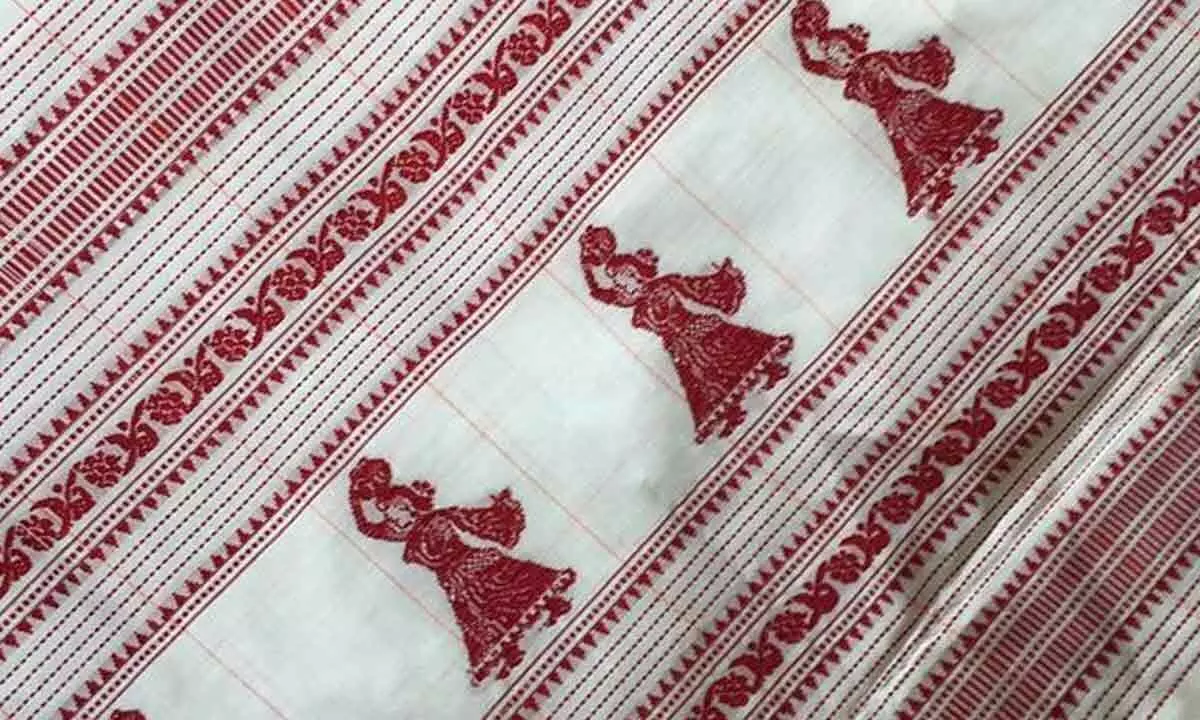Live
- Malaysian national held from Tamil Nadu for cyber fraud of Rs 2.81 crore
- Child marriage will be eradicated by 2026: Assam CM
- PMK President Anbumani Ramadoss urges TN government to act against online gambling
- From defence to culture and sports, India and Kuwait sign key agreements during PM Modi's visit
- Mahakumbh 2025: 110 mist blower machines and 107 fogging units to keep Akharas insect-free
- Piyush Goyal participates in Mahila Shakti Shivir event, calls Bima Sakhi Yojana 'a revolutionary initiative'
- Death toll from Cyclone Chido in Mozambique rises to 94
- 13 criminals from two gangs arrested in Jharkhand's Ramgarh for extortion
- Union Minister Bandi Sanjay Visits Injured Boy Sritej at KIMS Hospital
- Construction of over 1,000 bridges underway in Assam: CM Sarma
Just In
Let the Gollabhaamas dance – the untold glory of Siddipet sarees


Let the Gollabhaamas dance – the untold glory of Siddipet sarees
Marked by elegance, simplicity, and style, distinguished by quintessential motifs of Gollabhaamas (women holding milk pots), Siddipet sarees are eternal in their personality
Marked by elegance, simplicity, and style, distinguished by quintessential motifs of Gollabhaamas (women holding milk pots), Siddipet sarees are eternal in their personality.
A small town in the Medak district of Telangana, Siddipet is lesser known as a place and is associated more with its weave. That said, many saree enthusiasts of this generation, have a recollection of this weave through the word Gollabhaama, more than calling it Siddipet sarees. This is usually attributed to the fact that Siddipet sarees have the central theme of Gollabhaamas, running across most of their designs.
Given the fact that this weave is eternal in its design, and is one of the lesser-known clusters, it is often confused to be a product of this generation. However, one couldn't be further from the truth. Yes! The society for Siddipet sarees was established in the year 1948, and the weave per se goes back even further. Originally known for its extremely fine-count sarees with rave popularity back in the day, weaving Siddipet sarees is no child's play. A laborious process that to date employs the jala technique – 'an age-old weaving technique used since the golden era to bring alive intricate designs' – for the borders and pallu, even with options such as jacquard loom available at disposal. That must not be misinterpreted as imposing more work by the weavers on themselves but must be treated as a reason for celebration – of a cluster, sticking to its roots and authenticity, despite the pressure to mechanize everything.
Siddipet sarees carry a characteristic look of a plain body with intricately woven pallus and borders – filled with beautiful motifs of Gollabhaamas and Kolatams (a popular folk dance in southern India). With broadly three types of fabrics used in this cluster – cotton, mercerized cotton and silk – the highest demand for Siddipet sarees has always been for cotton and mercerized cotton and not so much for silk. In fact, the demand for silk in this cluster is very minimal and zari is also not employed in these sarees. The cotton sarees, on the other hand, are either of 100 or 120 fine counts and are best suited for tropical climatic conditions. In other words, soft, breathable, and comfortable - a smart wardrobe choice especially on a sunny day. While today Siddipet sarees are synonymous with their Gollabhaama motifs, it was only about 50 years ago that this technique was revived. Back in the day, only the locals sported the Siddipet sarees, and despite their popularity, these sarees never seemed to have gotten their due limelight given the extremely low pricing (as low as even 1 to 2 rupees!). But, thanks to the government for recognising their worth and granting them a Geographical Indication tag, along with social media bringing back the buzz and glory of this weave, Siddipet sarees seem to be carving a stronger niche for themselves today. Additionally, to keep up with the changing times and stay relevant in the game of weaves, the Siddipet weave did not shy away from embracing new designs, such as the bathukamma and kolatam motifs.
With around 50 weavers in Siddipet today, toiling their lives towards keeping this craft alive, just about 20 weavers are engaged in the Gollabhaama weave, with the rest involved in the Ikkat and other weaves. Also, the aforementioned GI tag was only granted to the Gollabhaama weave in Siddipet and not the others. The bittersweet reality of today is that there is an unprecedented rise in demand for Siddipet sarees, however, there are only 20 weavers to cater to the same. The next generation of these weavers, on the other hand, is leaning towards marketing more than weaving, which leaves the weavers (at an average age of 60) of yesteryears the only hope for this craft's sustenance.
But the good news is that the government seems to have stepped up its involvement in this cause through the SAMARTH scheme, by training the women of Siddipet with this craft and helping get more experts onboard to not just match the demand but find a way to keep it alive. Perhaps it is the blessing of Bathukamma Herself, who through Her name, hinted at the coming alive of this craft, one more time. And this time, hopefully, for an eternity.
So, with Her hand in ours, let us weave a new story of hope. Say a word of prayer for this craft, and get your hands on a Siddipet saree, because we'd rather stitch in time than cry over spilt milk.
(The writer is a handloom and handicraft enthusiast. She is also a member of crafts council. Instagram handle: Rajeswariramachander)

© 2024 Hyderabad Media House Limited/The Hans India. All rights reserved. Powered by hocalwire.com






